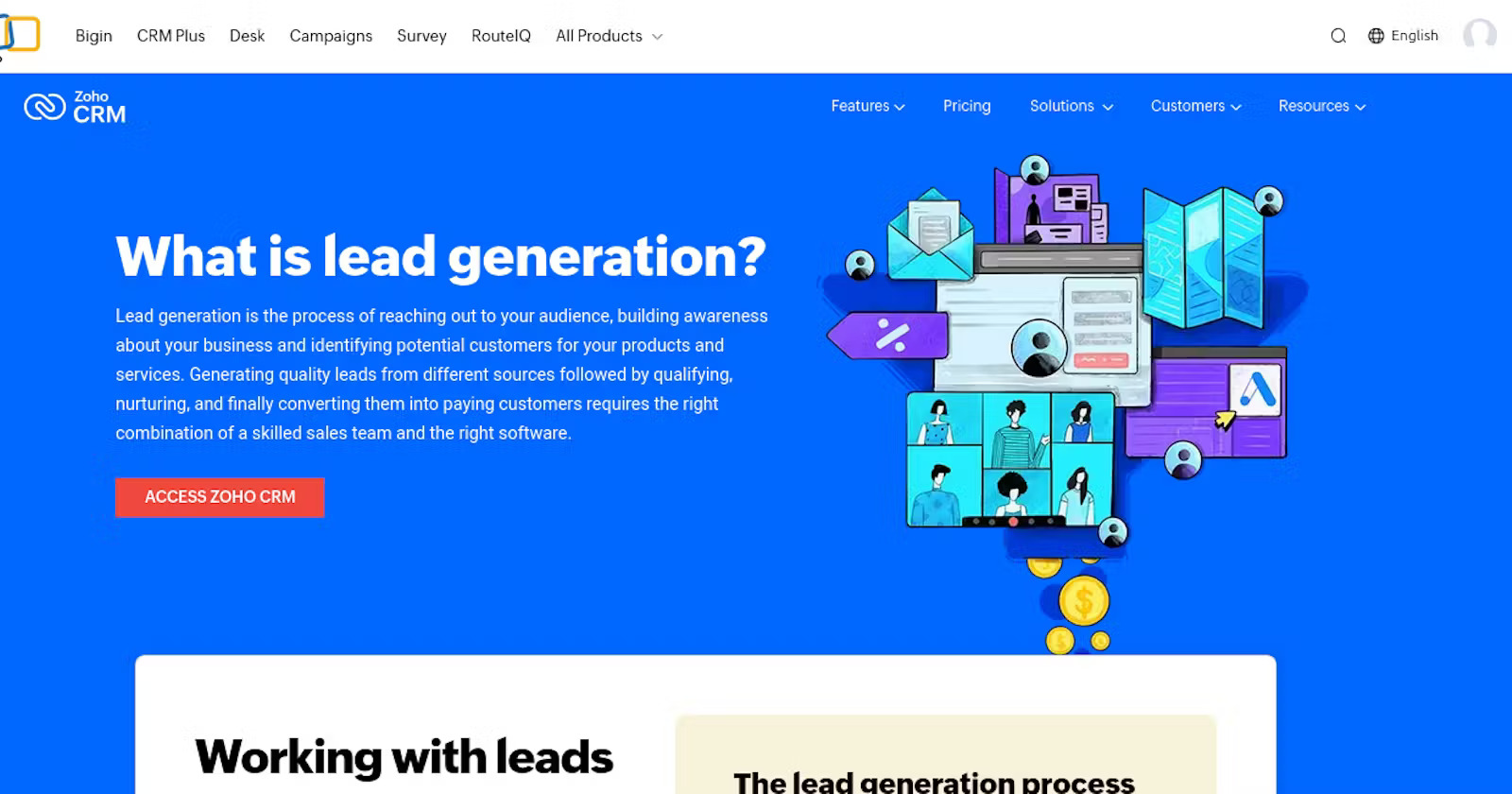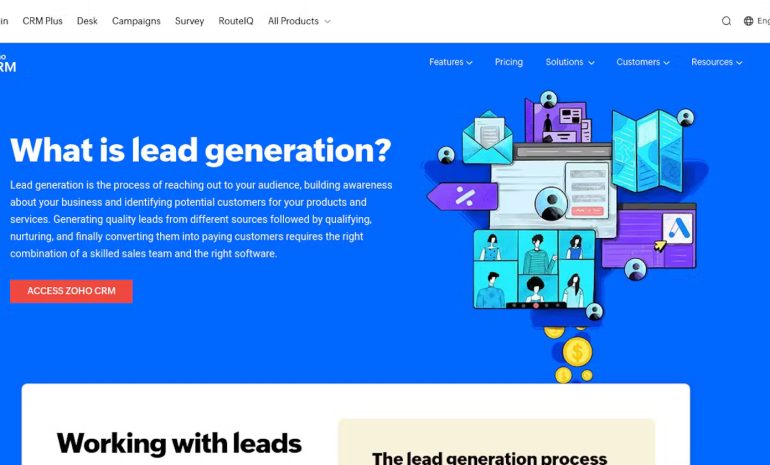
Lead management is the cornerstone of an effective sales strategy. Proper lead management ensures your team can effectively track, nurture, and convert leads into paying customers and Zoho CRM offers advanced tools to streamline this process.
In this detailed guide, we’ll explore the best practices for lead management in Zoho CRM, including a step-by-step process for setting up lead sources, lead scoring, segmentation, nurturing, and conversions.
Why Effective Lead Management is Critical
Effective lead management allows businesses to capture leads from multiple sources, track their interactions, score them based on engagement, and nurture them into deals. Here are some of the reasons why you should master lead management in Zoho CRM:
Increased Efficiency: Streamlining how teams handle incoming leads ensures they are never lost.
Better Targeting: Understanding and segmenting leads allows for personal follow-ups and campaigns.
Faster Response Time: Enables automation of lead distributions to ensure prompt action by teams.
Data-Driven Insights: Teams can use analytics to see what’s working and what’s not, improving overall lead conversion strategy.
Best Practices for Lead Management in Zoho CRM
1. Setting up Lead Sources in Zoho CRM
This is the first step as it enables us to understand where leads are coming from and also enables us to track lead sources automatically or manually, ensuring each lead can be attributed to a specific marketing effort.
Lead sources can be set up manually or automatically.
A. Manual Lead Source Setup
Lead sources can be manually set up based on known channels like trade shows, referrals, or cold calls.

Step-by-Step Guide:
- Go to Zoho CRM and click the Settings icon in the upper right corner.
- Under the customization section, select Modules and Fields.
- In the Leads Module, click the Standard Fields.
- Locate the Lead Source field.
- Customize the dropdown list by adding or removing sources that don’t apply to your business. You can add common sources like “Website,” “Referral,” or “Cold Call.”
- Click Save for the changes that are made.
B. Automatic Lead Source Setup
Zoho CRM integrates with various tools like Zoho Forms, Zoho SalesIQ, and website forms, allowing you to capture and categorize leads automatically based on their sources.
Step-by-Step Guide:
- Website Leads: To set up a web-to-lead form on your website, navigate to Settings > Channels > Webforms.
- Choose the leads module and design your form.
- Ensure you map the lead source field, so Zoho CRM automatically tracks where the lead originated (e.g., a website landing page).

- Zoho SalesIQ Integration: For leads coming from live chat on your website, integrate Zoho SalesIQ with Zoho CRM.
- Go to SalesIQ Settings > Integrations and connect it to Zoho CRM.
- Set up rules to capture chat leads automatically, marking the chat interactions as their lead source.

- Leads from Emails: Leads from email campaigns can be automatically added to CRM through integrations with Zoho Marketing Automation or Zoho Campaigns. Ensure that each campaign has the proper UTM tracking parameters set up.
By properly tracking lead sources, you can assess which marketing channels are driving the most qualified leads and invest more in those sources.
2. Implementing Lead Scoring for Prioritizing
Not all leads are created equal. Lead scoring allows you to prioritize leads based on their behavior and engagement, ensuring that your sales team focuses on the leads most likely to convert.
A. Create a Lead Scoring Model
Lead scoring in Zoho CRM assigns points based on a lead’s actions, such as opening emails, visiting websites, or downloading content. Lead scoring can also be based on demographic information like location or company size.

Step-by-Step Guide:
- Go to Settings > Automation and select Lead Scoring.
- Click Create Scoring Rule to start setting up your scoring model.
- Assign positive or negative points based on lead behavior. For example:
- +10 points for visiting the pricing page.
- +5 points for opening an email.
- +20 points for downloading an eBook.
- -10 points for inactivity after 30 days.
- Leads can also be assigned based on demographic data, like assigning +15 points to leads in your target demographic region or +20 points to leads from a specific industry.
- Once your scoring model is set, Zoho CRM will automatically adjust lead scores based on the above criteria.
B. Using Lead Scores for Better Segmentation
Steps to Segment Based on Leads Scores:
- In the Leads module, click the View Button.
- Set your criteria to show leads with a score greater than a certain threshold.
- Save this view as “High-Priority Leads,” and your sales team can work from this list for quick follow-up.
3. Lead Assignment and Distribution
Effective lead assignment ensures that no lead is left behind. In Zoho CRM, you can create assignment rules to automatically distribute leads among your sales team, based on criteria like geography, industry, or lead source.
A. Round-Robin Lead Assignment
For fair and efficient lead distribution, Zoho CRM allows you to set up round-robin rules so that leads are distributed evenly across your sales reps.

Step-by-Step Guide:
- Go to Settings > Automation > Assignment Rules.
- Click Create Rule, and name your rule “Round-Robin Lead Assignment.”
- Define the criteria for assigning leads (e.g., all leads from the website form).
- Choose the users who will receive leads through round-robin, ensuring even distribution.
- Save the rule, and leads will automatically be assigned as they enter the system.
B. Assignment Based on Custom Rules
If you want to distribute leads based on specific criteria, such as geography or product interest, you can create more tailored assignment rules.
Steps:
- Create a New Assignment Rule under Settings > Automation.
- Define conditions for assignment, such as “Lead Source is Trade Show” or “Location is North America.”
- Assign the leads to specific sales reps based on these rules.
4. Lead Segmentation for Targeted Campaigns
Segmentation allows you to divide leads into groups based on shared characteristics like geography, lead source, or behavior. This allows for more personalized communication and better-targeted campaigns.
A. Segmenting Leads in Zoho CRM

- Go to the Leads module.
- Click Create View to filter leads by criteria such as:
- Lead Source: Organize leads based on whether they came from your website, a referral, or an event.
- Lead Score: Segment leads based on their engagement level.
- Geography: Group leads by region to tailor your sales approach to specific markets.
- Save the view, and Zoho CRM will automatically populate the list with leads that match your criteria.
B. Using Segments for Nurturing
Once your leads are segmented, you can run targeted campaigns using Zoho Marketing Automation or other tools.
- Create nurturing workflows for each segment, such as sending a tailored email sequence to leads in a specific industry.
- Track engagement for each segment in Zoho CRM to measure the effectiveness of your personalized campaigns.
5. Automating Lead Nurturing
Nurturing leads requires consistent follow-up over time. Zoho CRM enables you to create automated workflows to send emails, SMS, or reminders to nurture leads and keep them engaged.
A. Creating Automated Nurturing Workflows

- Go to Settings > Automation and click Workflows.
- Click Create New Workflow and choose the Leads module.
- Set up a trigger, such as “Lead Score reaches 50” or “Lead has not been contacted in 7 days.”
- Define actions for the workflow, such as:
- Sending a personalized email sequence.
- Scheduling a call reminder for your sales team.
- Updating the lead status to “Nurturing.”
- Save and activate the workflow. Your leads will now automatically receive nurturing content based on their behavior or score.
B. Using Zoho CRM’s Blueprint for Lead Nurturing
Blueprints allow you to create structured processes for nurturing leads through predefined stages.
- Go to Settings > Automation > Blueprint.
- Create a blueprint for your lead nurturing process, defining stages like “Initial Contact,” “Follow-Up,” “Proposal Sent,” and “Negotiation.”
- Add automated actions, like sending an email or updating the lead status, at each stage.
- Activate the blueprint to guide your team through a consistent nurturing process.

6. Converting Leads into Deals
Once a lead is ready to buy, Zoho CRM allows you to seamlessly convert it into a deal, ensuring that your team can track progress through the sales pipeline.
A. Converting Leads into Deals Manually
- In the Leads module, select the lead you want to convert.
- Click the Convert button in the top-right corner.
- Create a new contact and account or link to an existing one.
- Optionally create a deal from the lead.
- Save the conversion, and the lead will now appear in the Deals module.
B. Automating Lead Conversion Based on Scoring
You can automate lead conversion when specific criteria are met, such as when a lead score crosses a threshold.
- Set up a Workflow Rule in Settings > Automation.
- Trigger the workflow when a lead score reaches a certain value or after a specific interaction.
- Add an action to automatically convert the lead into a deal when these conditions are met.
Conclusion
Mastering lead management in Zoho CRM involves careful setup and continuous optimization of your lead sources, lead scoring models, segmentation, nurturing workflows, and conversion processes. By following these best practices, you can ensure your team is working efficiently, your leads are well nurtured, and your sales pipeline remains full of high-quality prospects.
By leveraging Zoho CRM’s automation and customization features, you can streamline your entire lead management process, making your team more effective and improving your bottom line.

